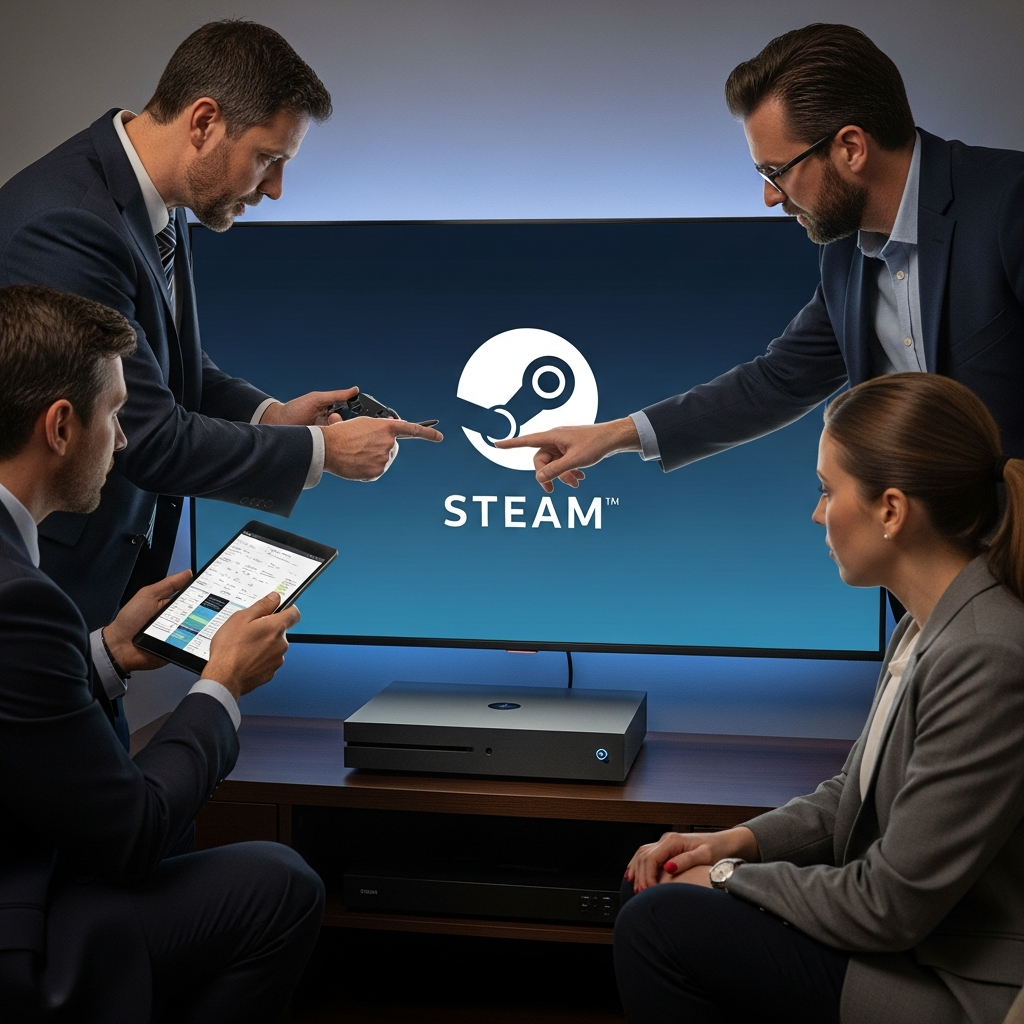Valve is back, rekindling its vision for living room PC gaming with a revamped Steam Machine. This compact, console-like device promises to bring the vast Steam library to your TV, building on the success of the Steam Deck. As anticipation mounts for its projected Early/Spring 2026 launch, one question dominates the conversation: how much will this new Steam Machine cost? Industry experts and analysts are deep-diving into Valve’s strategic playbook, hardware choices, and market positioning to predict a price that could redefine home gaming.
The Steam Machine: Valve’s Next Living Room Powerhouse
The new Steam Machine is designed as a powerful yet modest gaming PC, engineered to seamlessly integrate with your television. Described as a “goth Gamecube” without a handle, it’s roughly half the size of an Xbox Series X. Valve has confirmed a semi-custom AMD Zen 4 CPU (6 cores/12 threads) and an RDNA 3 GPU (28 CUs, 8GB VRAM) at its heart, complemented by 16GB DDR5 system RAM and SSD storage options of 512GB or 2TB. Valve claims this machine is over six times more powerful than the Steam Deck, targeting “4K gaming at 60 FPS” with the aid of AMD’s FidelityFX Super Resolution (FSR).
Valve’s Strategic Playbook: Lessons from the Steam Deck
Valve’s pricing strategy for new hardware is often aggressive, a lesson learned and perfected with the Steam Deck. The handheld was widely celebrated as an “absolute bargain,” partially because Valve was reportedly willing to sell it at a “painful” price point—potentially even at a loss initially. This was a critical move to ensure widespread adoption and cement Steam’s dominance in the portable gaming market.
With the Steam Machine, Valve aims for a similar ecosystem-building approach. By offering an accessible entry point to PC gaming in the living room, they hope to further normalize SteamOS as a viable gaming platform. This strategy solidifies Valve’s hold on its immense user base and continually funnels players into the Steam store, where the company earns significant revenue from game sales.
Unpacking the Hardware: Cost-Saving Innovations
Valve’s commitment to affordability is evident in the Steam Machine’s design and component choices. The device utilizes an older AMD Radeon RX 7600 (Navi 33 / RDNA 3) chip, with some elements reportedly “turned off.” This suggests Valve is sourcing cheaper, binned-off GPUs. Similarly, the decision to include 8GB of VRAM instead of 16GB is a deliberate “value play.”
The machine boasts a unitary internal design, featuring a single heatsink and fan, which simplifies manufacturing and reduces component count. A compact 200W power supply cleverly doubles as a structural chassis, saving further costs. Additionally, its spartan port selection, including just a single USB-C and one NVMe slot, points to a minimalist approach. Crucially, running SteamOS eliminates expensive Windows licensing fees, a significant cost advantage over traditional gaming PCs. Valve’s “considerable weight” and “vast financial resources” also allow it to negotiate substantial discounts on components through bulk, upfront orders.
Performance vs. Price: Where Does it Stand?
The Steam Machine’s hardware positions it uniquely in the gaming market. While “six times faster than a Steam Deck” sounds impressive, experts like those at IGN note its GPU is akin to an “overclocked laptop chip” running at a higher TDP. For true 4K/60fps gaming without heavy reliance on FSR, the GPU might appear “underwhelming,” as some analysts from Club386 observed.
When comparing to equivalent DIY PC builds, IGN estimated a similar component list could run upwards of $913. Gaming laptops with comparable specs might sit around $780 (including a screen!), while high-end mini PCs or NUCs can easily exceed $1,500. Valve’s challenge is to significantly undercut these figures, offering console-like value without matching console manufacturers’ willingness to sell hardware at a loss.
The Market Landscape: Competing with Consoles and Mini PCs
The Steam Machine faces a dual challenge: competing with established consoles and carving a niche among mini PCs. With the Xbox Series X Digital Edition at $599.99 and the rumored PS5 Pro around $749.99, Valve needs to strike a delicate balance. It aims to be a compelling alternative for console gamers by offering access to the vast and often discounted Steam library, without the mandatory online subscription fees common to consoles. This translates to better long-term value for players.
Conversely, the Steam Machine must differentiate itself from expensive Mini-ITX builds and niche gaming NUCs. Valve is betting on its integrated ecosystem, optimized SteamOS, and ease of use to appeal to a broader audience that might find traditional PC building daunting or prohibitively expensive.
Expert Predictions: What PC Gamer & Industry Analysts Say
The consensus among analysts points to an aggressively competitive Steam Machine price. The PC Gamer team’s collective “educated guess” averaged around $525. Here’s a breakdown of specific predictions:
Undercutting Consoles: Jeremy Laird (PC Gamer) anticipates the entry-level 512GB version will be under $499. Dave James (PC Gamer) echoes this, specifically predicting $499 for the 512GB model and $649 for the 2TB version, drawing parallels to Steam Deck OLED pricing.
Mid-Range Estimates: Jess Kinghorn and Andy Edser (PC Gamer) hope for a 512GB model between $500-$600, with the 2TB version “edging into $700 territory.” Nick Evanson (PC Gamer) is confident it won’t exceed $599 for the max SSD version. Jacob Ridley (PC Gamer Managing Editor) predicts $529 for 512GB and $649 for 2TB.
- Higher but Still Competitive: IGN’s analysis suggests a more realistic range of $700-$800, with an aggressive pricing strategy potentially pushing it down to $600, but doubts it will land below $500. Windows Central estimates $650-$750, placing it against the PS5 Pro. Tom’s Guide speculates around $800. Club386 estimated a DIY equivalent at £701.12, leading them to predict £500-600 for the 512GB model.
- www.pcgamer.com
- www.ign.com
- www.club386.com
- www.windowscentral.com
- www.tomsguide.com
The availability of two storage tiers (512GB and 2TB) gives Valve crucial flexibility to target both budget-conscious buyers and those willing to pay a premium for more space, effectively “top-and-tailing” the market.
Headwinds on the Horizon: Challenges to Affordable Pricing
Despite Valve’s best efforts and strategic component choices, several external factors could push the Steam Machine’s price higher. A significant concern is the ongoing global “RAM and storage price crisis.” The frenetic buildout of AI infrastructure is causing a “massive DRAM shortage,” impacting prices for DDR5, GDDR6, and SSDs—components central to the Steam Machine.
Supply chain disruptions, potential tariffs, and the inherent research and development (R&D) costs for new hardware also present challenges. These elements are largely “out of Valve’s hands” and could make hitting original low price targets extremely difficult, especially for higher-capacity models.
The “Painful” but “Critical” Price Point
Ultimately, Valve’s history suggests a willingness to absorb higher costs or thinner profit margins to achieve its overarching goal: widespread adoption of its hardware and ecosystem. The “painful” price point isn’t just about making a quick profit; it’s a strategic investment in the future of SteamOS and Valve’s platform dominance. By offering an attractively priced Steam Machine, Valve can counter growing competition from other gaming ecosystems and ensure its continued relevance in the rapidly evolving hardware market. This strategic gamble could mean an initial price that is highly appealing to consumers, even if it means sacrificing immediate profitability for long-term platform growth.
Frequently Asked Questions
What are the key hardware specs of the new Steam Machine?
The new Steam Machine features a semi-custom AMD Zen 4 CPU with 6 cores and 12 threads, paired with a semi-custom RDNA 3 GPU offering 28 Compute Units and 8GB of GDDR6 VRAM. It includes 16GB of DDR5 system RAM and comes with storage options of either 512GB or 2TB SSDs. This hardware combination aims to deliver performance over six times faster than the Steam Deck, targeting “4K gaming at 60 FPS” with FSR, and is projected for an Early/Spring 2026 release.
How might the Steam Machine’s price compare to existing gaming consoles?
Experts largely predict the Steam Machine will be priced competitively with, or even slightly under, current-generation consoles like the Xbox Series X Digital Edition ($599.99) and the rumored PS5 Pro ($749.99). Many analysts, including Dave James from PC Gamer, anticipate the 512GB model could launch around $499, with the 2TB version potentially at $649. Valve’s strategy emphasizes long-term value through no mandatory online subscriptions and access to a vast, often discounted Steam game library, contrasting with the console model.
What factors could influence the final price of the Steam Machine at launch?
Several factors could influence the Steam Machine’s final price. Valve’s history of aggressive “painful” pricing for ecosystem growth suggests a drive for affordability. Cost-saving hardware choices (older AMD GPU, 8GB VRAM, unified thermal design, SteamOS eliminating Windows licensing) are key. However, global challenges like the “massive DRAM shortage” impacting RAM and storage prices, supply chain disruptions, and R&D costs could push the price higher. Valve’s ability to absorb these costs will determine how close it gets to its target competitive price.
Conclusion: A Strategic Gamble for Valve
The upcoming Steam Machine represents Valve’s renewed commitment to its living room gaming vision. By leveraging an aggressive pricing strategy, value-focused hardware choices, and the immense pull of the Steam ecosystem, Valve aims to offer a compelling alternative to both traditional consoles and expensive mini PCs. While challenges like volatile component prices exist, the overarching sentiment points towards a machine designed to hit a “painful” but “critical” price point, prioritizing widespread adoption over immediate, high-profit margins. As the Early/Spring 2026 launch approaches, all eyes will be on Valve for the official reveal that could once again shake up the gaming hardware landscape.




